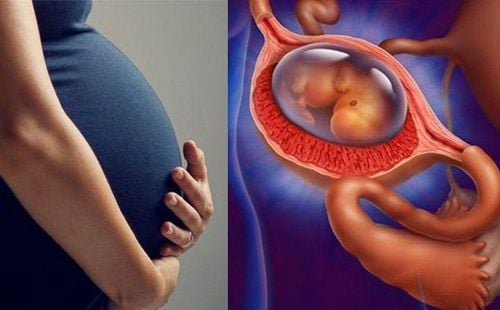This is an automatically translated article.
The article was professionally consulted by Specialist Doctor II Bui Minh Phuc - Department of Obstetrics and Gynecology - Vinmec Ha Long International Hospital. Doctor has more than 18 years working in the field of obstetrics and gynecology.Oxytocin is injected into the uterine muscle and by intravenous drip to stimulate uterine contractions to increase in frequency and intensity. The usual subjects for injection are women whose uterus does not contract well after a lower birth canal or during a cesarean section.
1. What is Oxytocin?
Oxytocin is a peptide hormone synthesized in the supraoptic and paraventricular nuclei of the hypothalamus and works by binding to a specific protein, oxytocin-neurophysin. Oxytocin is secreted from nerve endings in the posterior pituitary gland. Oxytocin acts on its receptors on uterine smooth muscle, helping to stimulate uterine contractions increasing both intensity, frequency and duration of uterine contractions. Oxytocin levels increase rapidly with the onset of labor and reach good levels in the period of delivery until uterine contractions.Oxytocin will be well absorbed by the parenteral route. In the gastrointestinal tract, oxytocin is broken down by gastric pepsin. Therefore, oxytocin is administered intramuscularly or intramuscularly and by intravenous drip. Oxytocin acts rapidly after intravenous infusion about 3-5 minutes.

Oxytocin có thể được truyền vào cơ thể qua đường tĩnh mạch
2. Indications and contraindications
2.1 Indications Indication of oxytocin injection for cases requiring increased uterine muscle activity such as: induction of labor, induction of labor, increased uterine contractions, treatment of postpartum haemorrhage due to uterine atony or postpartum. , after surgery after giving birth.2.2 Contraindications In particular, oxytocin can be dangerous if the fetus is still in the uterus. Therefore, it is absolutely contraindicated in the following cases:
Acute fetal failure Absolute cephalic asymmetry Central placenta previa Severe abortion Mother has cardiovascular disease causing disturbances in cardiac output

Oxytocin có thể gây nguy hiểm nếu thai vẫn ở trong buồng tử cung
3. The technique of injecting oxytocin into the uterine muscle
Inject oxytocin into the uterine muscle in cases where the uterus does not contract well after vaginal delivery or during a cesarean section.3.1 Oxytocin injection in case of vaginal delivery When oxytocin is injected into the uterine muscle, it is necessary to ensure that there is no placenta or placenta left in the uterus. Before administering oxytocin, the following procedures should be performed:
Control of the uterus. Catheterize before injection to prevent injection into the bladder. Disinfect the abdominal wall before injection. Oxytocin can be used 5-10 units. Injecting oxytocin should use a needle that is not too large to prevent bleeding, and also not too small to easily clog. After controlling the uterus, use the hand inside the uterus to push the uterus forward against the anterior abdominal wall. Insert the needle into the front of the fundus of the uterus, do not insert the needle too deeply, the medicine will enter the uterine cavity and will not have the effect of causing the uterus to contract. After pumping all the medicine into the uterine muscle, withdraw the hand in the uterine cavity.
3.2 Oxytocin injection during cesarean section During a cesarean section, after the pregnancy has been removed from the uterus, 5 units of oxytocin can be injected into the uterine muscle to help the uterus contract well and easily remove the placenta. If the uterus does not contract well, after the injection, you can massage the body of the uterus with your hands to make the uterus shrink. When injecting oxytocin, it should be injected into the muscle layer at the bottom of the uterus, the needle should not be inserted too deep, the drug will enter the uterine cavity, nor should the drug be injected too shallowly, it will inflate the uterine peritoneum and not cause the uterus to contract. .

Sau khi mổ lấy thai có thể tiêm oxytocin để lớp rau bóc tách được dễ dàng
4. Intravenous oxytocin drip
The technique of intravenous oxytocin infusion in cases of induced labor to induce contractions or to induce normal uterine contractions. The purpose of IV drip is to be able to actively regulate contractions, keep uterine contractions at a physiological level, avoid cases of contractions that are too strong or too weak, so using oxytocin to control birth.Mix 5 units of oxytocin into 500ml of 5% isotonic sweet serum and infuse intravenously, so that each drop of serum will have 1/200 units of oxytocin. During oxytocin infusion, it is necessary to closely monitor uterine contractions, fetal heart rate, and labor progress to prevent complications of oxytocin infusion such as fetal distress, uterine contractions, uterine rupture. The duration of oxytocin infusion should also not be longer than 5 hours to avoid complications of postpartum uterine atony.
In summary, oxytocin is injected into the uterine muscle and by intravenous drip to stimulate uterine contractions to increase the frequency, intensity and duration of uterine contractions.
Vinmec International General Hospital is one of the hospitals that not only ensures professional quality with a team of leading medical doctors, modern equipment and technology, but also stands out for its examination and consultation services. comprehensive and professional medical consultation and treatment; civilized, polite, safe and sterile medical examination and treatment space.
If you have a need for consultation and examination at the Hospitals of the National Health System, please book an appointment on the website for the best service.
Please dial HOTLINE for more information or register for an appointment HERE. Download MyVinmec app to make appointments faster and to manage your bookings easily.













